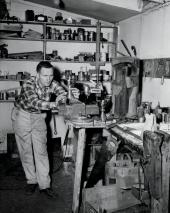
John Nugent was born on January 5, 1921, in Montreal and studied at St. John’s University (Collegeville, Minnesota), where he was exposed to liberal ideals and the post-war renewal in the arts that was sweeping the Catholic Church. In 1948, he moved to Lumsden, Saskatchewan and executed liturgical commissions in silver and bronze, while supporting his family as a chandler. The simplified, yet expressive forms of his chalices and crucifixes demonstrate an interest in modern interpretations of early Christian and Romanesque models. Resistance from the Church hierarchy and from parishioners caused him to cease his liturgical work in the 1960s. After his candle works in Lumsden burned down in 1960, Nugent commissioned Clifford Wiens to design a studio with a novel curved, conical design that earned the Regina architect a Massey silver medal award. In 1961, while on a trip to New York to study bronze casting, Nugent visited the studio of American sculptor David Smith; this encounter was to influence his move to welded steel abstraction. The awkward grace of Nugent’s steel sculpture, for which he is best known, results from a constructivist collage of prefabricated elements. While often incorporating identifiable parts, such as wheels, his sculpture eludes easy metaphorical readings, instead creating meaning through unexpected combinations of forms and materials. Nugent’s work represents an independent strain within Canadian abstract steel sculpture without direct ties to the Emma Lake Artists’ Workshops or other western Canadian sculptors. Nugent’s welded steel sculpture has met with controversy at times. His proposal for a soaring abstract monument to Louis Riel was rejected by Premier Ross Thatcher, who demanded in its place a representational figure. Unveiled in 1968, Nugent’s heroic nude statue, to which the premier had forced him to add clothing, was removed from the Saskatchewan Legislature grounds in 1991 after protests from the Métis community. Nugent’s #1 Northern (1976) was also removed from its site in front of Winnipeg’s Canadian Grain Commission building in 1978, but was later restored in 1997. Nugent, who taught at the University of Regina from 1970 to 1985, has also executed public commissions for the Banff Centre, the National Capital Commission (Ottawa), and the CBC Broadcast Centre (Regina). In 1983, his work was the subject of a major retrospective, John Nugent: Modernism in Isolation, organized by the MacKenzie Art Gallery in Regina. In the 1990s, Nugent shifted his attention from sculpture to photography. His work can be found in the collections of the MacKenzie Art Gallery, the Robert McLaughlin Gallery (Oshawa), the Saskatchewan Arts Board, the University of Regina, and the Winnipeg Art Gallery.
Timothy Long
Print EntryHOME | BROWSE BY SUBJECT | ENTRY LIST (A-Z) | IMAGE INDEX | CONTRIBUTOR INDEX | ABOUT THE ENCYCLOPEDIA | SPONSORS TERMS OF USE | COPYRIGHT © 2006 CANADIAN PLAINS RESEARCH CENTER, UNIVERSITY OF REGINA | POWERED BY MERCURY CMS |
|||
| This web site was produced with financial assistance provided by Western Economic Diversification Canada and the Government of Saskatchewan. |
|||
 |
 |
 |
 |
| Ce site Web a été conçu grâce à l'aide financière de Diversification de l'économie de l'Ouest Canada et le gouvernement de la Saskatchewan. |
|||